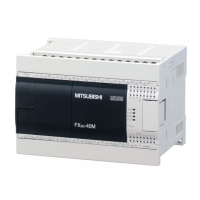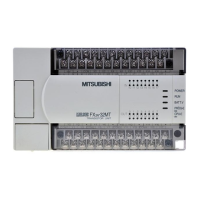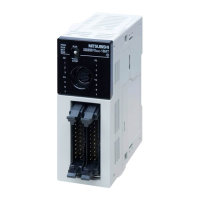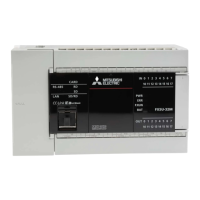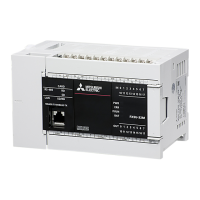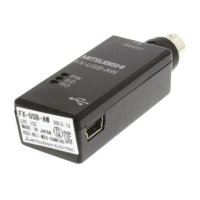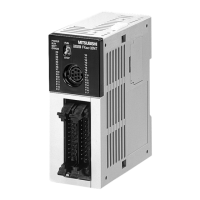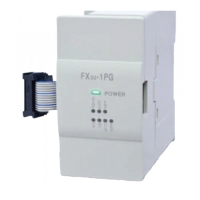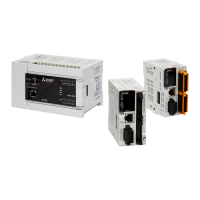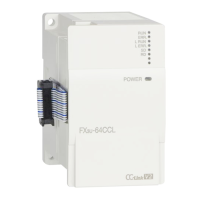
Do you have a question about the Mitsubishi Electric MELSEC FX3U and is the answer not in the manual?
| Model | FX3U |
|---|---|
| Type | PLC (Programmable Logic Controller) |
| CPU | 32-bit |
| I/O Points | Up to 384 points |
| Programming Language | Ladder Diagram, Structured Text |
| Program Memory | 64K steps |
| Execution Speed | 0.065 μs per basic instruction |
| Power Supply | AC 100-240V, DC 24V |
| Output Type | Relay, Transistor |
| Communication Ports | RS-422, RS-485, USB |
| Operating Temperature | 0 to 55 °C |
| Storage Temperature | -25 to 70 °C |
| Humidity | 5 to 95% RH, non-condensing |
| Vibration Resistance | 10 to 57 Hz |
| Built-in Analog | Available on some models (FX3U-**AD and FX3U-**DA) |
Explains the three types of programming languages supported: List, Circuit, and SFC programming.
Covers high-speed counters, I/O refresh, input filter adjustment, and pulse catch functions.
Highlights applied functions for data transfer, comparison, arithmetic, logical operations, and high-speed processing.
Explains the various built-in devices such as I/O relays, auxiliary relays, state relays, timers, and counters.
Explains the memory structure, memory operations, types of backup methods, and device initialization.
Lists parameters for setting the PLC environment, including memory capacity, comment area, and I/O assignment.
Explains basic instructions for contacts (LD, LDI, etc.), output coils (OUT, SET, RST), master control, and other instructions.
Lists applied instructions categorized by function, such as Program Flow, Move and Compare, Arithmetic and Logical Operations, and Rotation and Shift.
Lists device numbers and their assignments for I/O relays, auxiliary relays, state relays, timers, and counters.
Explains timer types, functions, operation examples, and set value specification methods.
Details counter types, features, related devices, functions, and set value specification methods.
Covers types, device numbers, input assignments, handling, and cautions for high-speed counters.
Explains data registers for storing numeric data and file registers for initial values, including structures and functions.
Details index registers (V and Z), their functions, structures, and indexing methods.
Explains pointers for branch and interrupt functions, including their numbers and operations.
Explains the roles and functions of numeric values like octal, decimal, hexadecimal, and real numbers.
Details specification of constants K (decimal), H (hexadecimal), and E (floating point) for operations.
Explains character string constants and character string data, including their storage and usage.
Explains indexing in basic and applied instructions, covering how to use index registers for device number modification.
Guides on how to interpret the format of applied instructions, including mark meanings and operand types.
Explains programming procedures and execution order, double output operations, and circuits that cannot be programmed.
Covers expression and operation type, handling of general flags, operation error flags, and limitations in the number of instructions.
Explains LD and LDI instructions as contacts connected to bus lines for starting branches.
Details instructions for driving output coils such as OUT, SET, RST, PLS, and PLF.
Explains AND and ANI instructions for connecting one contact in series.
Covers contact instructions that detect rising edge (LDP, ANDP, ORP) and falling edge (LDF, ANDF, ORF).
Explains the MPS, MRD, and MPP instructions for storing, reading, and popping intermediate results of PLC operations.
Details SET instruction for latching a bit device ON and RST instruction for resetting it OFF.
Explains the CJ instruction, including its operation with contacts and coils, double coil operation, and retentive timers.
Details cautions on subroutines and interrupt routines, including timer and counter usage.
Explains comparison of values in binary format and outputting results to bit devices.
Explains MOV and MOVP instructions for transferring contents of devices.
Details the function of BMOV instruction for transferring data between file registers and data registers.
Explains BCD and BCDP instructions for converting binary data into binary-coded decimal data.
Details BIN and BINP instructions for converting binary-coded decimal data into binary data.
Explains ADD and ADDP instructions for executing addition by two values to obtain the result.
Details SUB and SUBP instructions for executing subtraction using two values.
Explains MUL and MULP instructions for executing multiplication by two values.
Details DIV and DIVP instructions for executing division by two values.
Explains ROR and RORP instructions for shifting and rotating bit information rightward.
Details ROL and ROLP instructions for shifting and rotating bit information leftward.
Explains SFTR and SFTRP instructions for shifting bit devices rightward by a specified number of bits.
Details SFTL and SFTLP instructions for shifting bit devices leftward by a specified number of bits.
Explains ZRST and ZRSTP instructions for resetting devices in a zone at one time.
Details DECO and DECOP instructions for converting numeric data into ON bit.
Describes SUM and SUMP instructions for counting the number of "1" (ON) bits in data.
Details SQR instruction for obtaining the square root of binary floating point data.
Explains REF and REFP instructions for outputting the latest input or output status in the middle of a sequence.
Details HSCS instruction for comparing value counted by a high speed counter with a specified value.
Explains HSCR instruction for resetting a high speed counter.
Details HSZ instruction for comparing current value of a high speed counter with two values (zone).
Explains how devices are automatically switched and controlled when the command input is ON.
Details SER and SERP instructions for searching same data, maximum value, and minimum value in a data table.
Explains ABSD instruction for creating output patterns corresponding to current value of a counter.
Explains TTMR instruction for measuring the period of time in which TTMR instruction is ON.
Describes STMR instruction for easily making off-delay timers, one-shot timers, and flicker timers.
Explains ALT and ALTP instructions for alternating a bit device when the input turns ON.
Explains TKY instruction for setting data to timers and counters through ten key inputs from "0" to "9".
Details HKY instruction for multiplexing four X-devices and four Y-devices to allow 16 key (0 to F) 4-digit (byte) input.
Explains DSW instruction for reading the set value of digital switches.
Details SEGD and SEGDP instructions for decoding data and turning the seven-segment display unit ON.
Explains SEGL instruction for controlling one or two sets of 4-digit seven-segment display units.
Details ARWS instruction for inputting data through arrow switches used for shifting digit and incrementing/decrementing numeric value.
Explains RS instruction for sending and receiving data in no-protocol communication by way of serial ports.
Details ASCI instruction for converting hexadecimal code into ASCII codes.
Explains HEX instruction for converting ASCII codes into hexadecimal codes.
Details CCD instruction for calculating horizontal parity value and sum check value.
Explains VRRD instruction for reading analog value of a variable analog potentiometer board.
Details VRSC instruction for reading the value of a variable analog potentiometer and converting it to binary value.
Explains ZPUSH/ZPUSHP instructions for temporarily batch-storing present values of index registers.
Details ZPOP and ZPOPP instructions for restoring batch-stored index registers.
Explains DECMP and DECMPP instructions for comparing two data (binary floating point).
Details DZCP and DZCPP instructions for comparing data with two values (zone).
Explains EMOV and DEMOV instructions for transferring binary floating point data.
Details ESTR and DESTRP instructions for converting binary floating point data into character strings.
Explains EVAL and DEVALP instructions for converting character strings into binary floating point data.
Details EBCD instruction for converting binary floating point to scientific notation.
Explains EBIN instruction for converting scientific notation to binary floating point.
Details ADD and ADDP instructions for executing addition of two binary floating point data.
Explains SUB and SUBP instructions for executing subtraction of two binary floating point data.
Explains WSUM and WSUMP instructions for calculating the sum of consecutive 16-bit or 32-bit data.
Details WTOB and WTOBP instructions for separating 16-bit data into byte units.
Explains BTOW and BTOWP instructions for combining low-order 8 bits of consecutive 16-bit data.
Details UNI instruction for combining low-order 4 bits of consecutive 16-bit data.
Explains DIS instruction for separating 16-bit data into 4-bit units.
Details SWAP instruction for swapping high-order 8 bits and low-order 8 bits of a word device.
Explains SORT2 instruction for sorting data tables based on specified group data.
Explains DSZR instruction for executing zero return and aligning mechanical position.
Details DVIT instruction for executing one-speed interrupt constant quantity feed.
Explains TBL instruction for executing one specified table operation from data table set in GX Developer.
Details ABS instruction for reading the absolute position (ABS) data.
Explains ZRN instruction for executing zero return and aligning mechanical position.
Explains TCMP instruction for comparing comparison time with time data and outputting result to bit devices.
Details TZCP instruction for comparing two comparison times (zone) with time data.
Explains TADD instruction for executing addition of two time data and storing result to word devices.
Details TSUB instruction for executing subtraction of two time data and storing result to word devices.
Explains HTOS instruction for converting time data in units of hour, minute, and second into data in units of second.
Details STOH instruction for converting time data in units of second into data in units of hour, minute, and second.
Explains TRD instruction for reading clock data of the real time clock built in a PLC.
Details TWR instruction for writing clock data to the real time clock built in a PLC.
Explains GRY instruction for converting binary value into gray code, and transfers it.
Details GBIN instruction for converting gray code into binary value, and transfers it.
Explains RD3A instruction for reading analog input value from analog block FX0N-3A or FX2N-2AD.
Details WR3A instruction for writing digital value to analog block FX0N-3A or FX2N-2DA.
Explains FLCRT instruction for creating a file inside CompactFlashTM card and evaluating file ID.
Explains COMRD instruction for reading comment data for registered devices written to PLC.
Details RND instruction for generating random numbers.
Explains DUTY instruction for generating timing signal with specified period and ON duration.
Details CRC instruction for calculating CRC value, which is an error check method used in communication.
Explains HCMOV instruction for updating current value of a specified high speed counter or ring counter.
Explains BK+ instruction for adding binary block data.
Details BK- instruction for subtracting binary block data.
Explains BKCMP instructions for comparing block data in various conditions.
Explains STR instruction for converting binary data into character strings (ASCII codes).
Details VAL instruction for converting character strings (ASCII codes) into binary data.
Explains $+ instruction for linking character strings.
Details RIGHT instruction for extracting specified number of characters from the right end of a character string.
Explains LEFT instruction for extracting specified number of characters from the left end of a character string.
Explains FDEL instruction for deleting arbitrary data from a data table.
Details FINS instruction for inserting data into an arbitrary position in a data table.
Explains POP instruction for reading the last data written by shift write (SFWR) for FILO control.
Explains LD instructions for comparing numeric values and setting a contact to ON when the condition agrees.
Details AND instructions for comparing numeric values and setting a contact to ON when the condition agrees.
Explains LIMIT instruction for providing upper and lower limit values for input numeric value and controlling output.
Details BAND instruction for providing upper and lower limit values of dead band for input numeric value.
Explains ZONE instruction for controlling output value based on positive or negative input value.
Details SCL instruction for executing scaling of input value using a specified data table.
Explains DABIN instruction for converting numeric data expressed in decimal ASCII codes into binary data.
Details BINDA instruction for converting binary data into decimal ASCII codes.
Explains IVCK instruction for reading the operation status of an inverter.
Details IVDR instruction for writing an inverter operation required control value to an inverter.
Explains IVRD instruction for reading an inverter parameter.
Details IVWR instruction for writing an inverter parameter.
Explains IVBWR instruction for writing parameters of an inverter at one time.
Explains RBFM instruction for reading data from continuous buffer memories (BFM).
Details WBFM instruction for writing data to continuous buffer memories (BFM).
Explains HSCT instruction for comparing high speed counter value with data table.
Explains LOADR instruction for reading current values of extension file registers (ER) stored in memory cassette or EEPROM.
Details SAVER instruction for writing current values of extension registers (R) to extension file registers (ER).
Explains INITR instruction for initializing extension registers (R) and extension file registers (ER) to HFFFF.
Details LOGR instruction for logging specified devices and storing data to extension registers and file registers.
Explains RWER instruction for rewriting extension registers (R) to extension file registers (ER).
Details INITER instruction for initializing extension file registers (ER) to HFFFF.
Explains FLCRT instruction for creating a file inside CompactFlashTM card and evaluating file ID.
Details FLDEL instruction for deleting files stored in CompactFlashTM card or formatting it.
Explains FLWR instruction for writing data to CompactFlashTM card or buffer inside FX3U-CF-ADP.
Details FLRD instruction for reading data from CompactFlashTM card.
Explains FLCMD instruction for giving instruction for operation to the FX3U-CF-ADP.
Details FLSTRD instruction for reading the status of the FX3U-CF-ADP.
Explains sequence control using SFC (sequential function chart), including roles of state relays and operation.
Details step ladder instructions, expressions, and cautions, comparing them with SFC programs.
Explains input interrupt function triggered by external signal, covering its application and programming procedure.
Details timer interrupt function for executing interrupt routine at every specified cycle time.
Explains pulse catch function for monitoring short-time pulse signals.
Details pulse width/pulse period measurement function for measuring pulse width or period.
Lists special auxiliary relays and special data registers, their numbers, and functions.
Explains supplementary special devices like RUN monitor, initial pulse, battery voltage, power failure detection, scan time, and internal clock.
Describes the states and colors of LEDs for PLC operation status (POWER, RUN, BATT, ERROR).
Explains methods for checking error codes by display module and GX Developer.
Details special devices used for error detection, such as M8060-M8067 and D8060-D8067.
Lists error codes and their corresponding actions for troubleshooting PLC errors.

